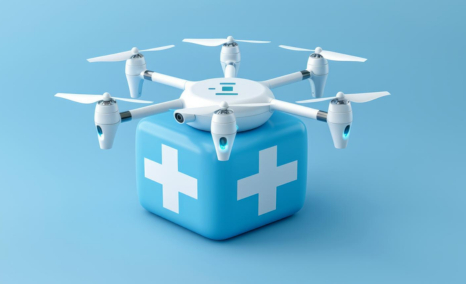Drones, also referred to as unmanned aerial vehicles (UAVs)/unpiloted aircraft, are remotely piloted to meet various needs. Drones are one of the emerging technologies that are reshaping the transportation system. Earlier, the main use of drones was for a military expedition, however, today the drones can be seen in commercial & civilian use, making their way in several other sectors such as e-commerce, mining, chemicals industry, forest conservation, construction, geography mapping, filmmaking, petrochemicals, (Oil & Gas), public safety (i.e the law enforcement, fire departments, search and rescue operations), and many others.
Similarly, the healthcare industry is no exception to drone delivery systems. Drones are providing a new dimension to the healthcare system and consumers. Although the use of drones in healthcare is at an early stage, however in the coming years the adoption rate is expected to rise significantly. The rise in technology, increasing investment, and support from the government will be the leading factors for the adoption of drones. Similarly, these factors are also expected to expand the healthcare products and services delivery in remote areas. It can be a supportive arm to the existing healthcare system with many potential benefits. In the past two years, the Covid-19 pandemic has also accelerated medical drone development and its use. Several companies have started exploring the potential of drones in essential medical supplies. Similarly, health authorities have also used drones to surveillance virus-infected isolated areas. Looking at the current situation and the development in the segment the drones are likely to provide valuable healthcare services in a more efficient and effective manner in the coming years.
Potential Benefits of Drones in Healthcare
The most primary application of drones in healthcare is the delivery of medication and prescriptions. In some advanced cases, it can be utilized to transport biological samples such as blood, plasma, and other tissues. Access to healthcare in rural and remote locations is a severe challenge. To overcome this issue, drones can be used for the delivery of medications that are inaccessible via bus, truck, or train. But definitely, the area needs to be well equipped with a communication system. Apart from medicine, drones can be used to supply diagnostic kits, organs, small medical devices, and laboratory samples collection.
In the case of medical emergencies, drones are one of the best alternatives to deliver essential medical equipment and medicines. They can minimize the transport time significantly and can save the lives of critically ill patients. Organ transport is one of the best examples of emergency service. Similarly, in the case of cardiac arrest, traumatic injuries, and other similar situations drone is a better option to deliver essential suppliers as compared to the other mode of transportation.
The drones can also be used for public safety such as against viral diseases. To fight the infection, drones can be employed to disinfecting areas such as parks, stations, supermarkets, and courtyards, etc. It can spray an area more efficiently and without the active involvement of the person. In the future, the scope and application of drones for cleaning public places can be more diverse. Similarly, it can be used for contactless delivery of hazardous material, surveillance of isolated areas, and other medical supplies.
Analyzing the benefits and applications, drones can be valuably utilized in the healthcare delivery system that can improve the overall patient experience.
Leading Medical Drone Delivery Companies
Worldwide, several startups are conducting trial run programs and moving forward to commercially utilize the drone for healthcare delivery. The leading companies in the medical drone delivery market include Zipline, Novant Health, Vayu, Matternet, SZ DJI Technology, Embention, Flirtey, Flirtey, Ehang, Tu Delft, Project Wing, HiRO (Healthcare Integrated Rescue Operations), and others. Looking at the market potential several new players are expected to enter the market in the coming years with more innovative and advanced applications.
Limitations of Drones in Healthcare
Despite several favorable applications, the drone has some limitations in the healthcare delivery system. The technical aspects such as short battery life, speed, vibration, low load capacity, g-force, and precision can negatively impact the flight of the drone. The availability and the frequency of drone landing stations influence drone use and their performance. A continuous communication system needs to be maintained between a ground pilot and the vehicle to operate the drone. Moreover, environmental factors such as humidity, rapid changes in pressure, and temperature also need to be considered while delivering critical medical products. Adverse weather conditions can impact the quality of the medical supply.
Similarly, social acceptance is necessary for the wide-scale adoption of drones. The large-scale deployment can affect the labor market and can lead to unemployment. Delivery of the medical supply requires the personal data of the consumer. To overcome the security breach, companies need to follow data security and compliance strictly. The drones are equipped with cameras and sometimes people may feel an invasion in their privacy and private property. The high economic cost of the carriage is another issue.
On the legal front, the strict law and regulations are hampering the launch and adoption of drone delivery systems. Each country follows a different rule to operate drones and there is a lack of a streamlined process for approval and operations. Similarly, drones possess a severe threat to aircraft, the companies need to take necessary approval from the aviation authorities as well and require to follow certain specific routes.
What Lies Ahead
Drone delivery is still in its infancy. Companies are conducting test flights across different geographies with a high success rate. The Zipline has collaborated with the Health Ministry of Rwanda to launch the drone delivery system in the country. Zipline has also delivered personal protective equipment to health centers in North Carolina via drones. The company is exploring the opportunity in other countries as well. Volansi, a drone startup has partnered with Merck to deliver “cold-chain” medicines to rural parts of North Carolina. Similarly, Skyports, a UK-based company is assisting the NHS and conducting hospital-to-hospital medical deliveries in the battle against COVID-19. Along with these several other companies are exploring the possibility of drones in the healthcare delivery system.
In the coming years, drone delivery coupled with emerging technologies such as telehealth can revolutionize the healthcare delivery system. However, in order to develop and motivate companies and other stakeholders, the government needs to frame transparent guidelines and at the same time need to ensure appropriate handling of the medical products. The drone delivery market is expected to witness growth in the coming year with the rise in investment, increasing partnership & collaboration, and increasing technological advancements. There is no doubt that drones have limitless application in the healthcare system, but the high cost of drones, rules, and regulations, social acceptance, and technological glitches are needed to address to ensure the wide-scale adaptability of drones in the healthcare system.



